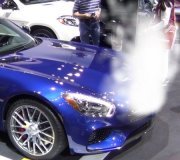Now during this experience the 454 ate a lifter with not even 100 miles on it. So I chose this time to pull the engine and make sure all water passages were clear, re checked everything new cam and lifters. Reinstalled and the same thing over again it overheated again. I did a check for exhaust gases in water, there was none detected. Still this thing overheats. Last result I installed a 4 core radiator, with the 2 -12" fans but had to lose the shroud and put fans straight to radiator due to clearance problems but I got er in there. It seemed to help a little but it still overheats. I drove it to a car show which was maybe 5 miles, only two quick stops then all freeway driving, while driving only 60mph, still when I parked the car it was at 220deg and puked water out on the ground. Since it was at night on the way home it did run cooler, the days were in the 90deg range when test driving. That night after getting it home it was around 205, I pulled it into the garage put a large fan in front to see what would happen and it still reached 230 when I shut it off. I have no idea how to proceed. I changed temp gauges, just to make sure. This car is equipped with air cond. I cant even turn that on, or figure out what to do next. I know how every thing works, this should not be overheating. I am so frustrated at what to do next. Please help with something I have missed. Thanks so much.
SPONSORED LINKS
Wednesday, June 25th, 2014 AT 3:56 PM



